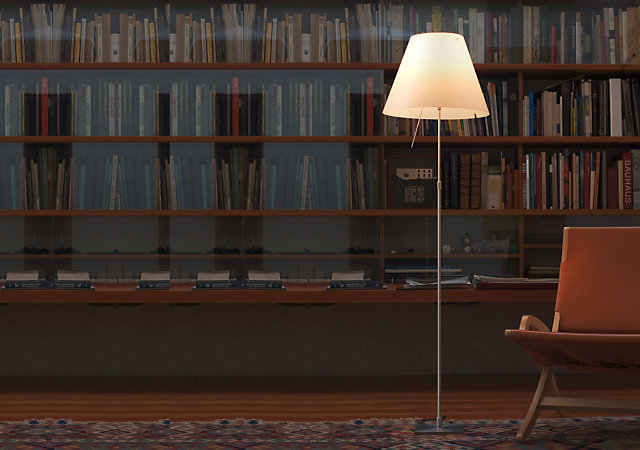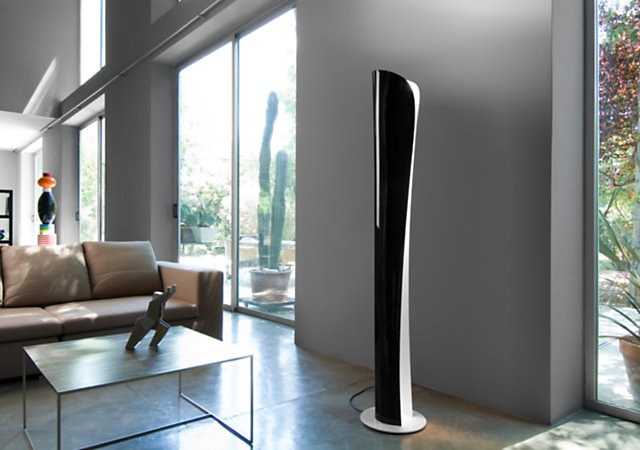Floor lights are mobile and emit their light wherever you position them. It is beneficial, for example, that they can be controlled from the comfort of your own seat on a sofa or in an armchair. Floor lamps are better at providing ambient lighting than table lamps as they can be equipped with bulbs with higher wattages. This is because the height of floor lamps makes it impossible to look at the bulb, which means that the risk of glare is thereby prevented. A typical version of a floor lamp is a floor uplighter, which emits its light upwards. Furthermore, other available versions include shaded lamps, which emit their light both upwards and downwards as well as adjustable reading lamps emitting their light downwards.

Upward and downward light emission
Floor lamps which emit their light upwards and downwards combine
ambient lighting with
zone lighting.The upward-directed light illuminates the ceiling and is scattered throughout the entire room. At the same time, the zone lighting emitted downwards illuminates a defined area.
Typical areas of use: this type of lamp is usually used to illuminate sofas and armchairs in the living room. Here, it combines ambient lighting for general orientation purposes with directed
zone lighting for reading.
Standard version: floor lamps which emit their light upwards and downwards usually have a base with an arm which has a shade or reflector attached to it.
The light11 recommendation
- To avoid glare, the illuminant must not be directly visible. The lampshade should hide the illuminant so that you cannot look directly into it while you are standing as well as while you are in a sitting position. This can be guaranteed by the light sources being covered or by the lampshades being suitably tapered. In no case may the lampshade be transparent enough for bulbs to shine brightly through it and to thereby cause glare. Ideally, the lampshade is slightly transparent so that it has a pleasant glow.
- If the floor lamp is required to supply reading light for armchairs and sofas, the zone lighting directed downwards must not only illuminate a small area around the light fixture. It has to completely illuminate the reading area with a sufficiently bright light.
- If the floor lamp is required to supply reading light for armchairs and sofas, the zone lighting directed downwards must not only illuminate a small area around the light fixture. It has to completely illuminate the reading area with a sufficiently bright light.

Upward light emission
Floor lamps which emit their light upwards provide ambient lighting by illuminating ceilings; from here, the light is then dispersed throughout the entire room.
Typical areas of use: this type of lamp is used for providing ambient lighting for general orientation purposes in living rooms, dining rooms, bedrooms, studies, kitchens and hallways.
Standard version: floor lamps with upward light emission are known as
floor uplighters. They usually have a base with an arm which has a reflector or a shade with an upwards pointing opening.
The light11 recommendation
- Floor lamps with upward light emission should emit their light broadly and evenly to illuminate a large area of the ceiling. If the ceiling is only illuminated at a specific point, your eyes feel blinded by the bright spot of light.
- Floor uplighters with a flexibly adjustable shade or reflector are recommended for sloped walls and ceilings.
- It is recommended to use a light fixture with a dimmer as this allows for an individual adjustment of the lighting mood.

Adjustable lamps with downward light emission
Floor lamps that emit their light downwards supply direct zone lighting that brightly illuminates a defined area.
Typical areas of use: this type of lamp provides zone lighting for reading on a sofa, in an armchair or in bed. Furthermore, oversized floor lamps, the so-called
arc lamps are also available. These have arms which reach so high and so far that they can be used as pendant luminaires to provide zone lighting above coffee tables or dining tables.
Standard version: floor lamps which emit their light downwards usually have a base with a flexibly adjustable arm and an attached adjustable shade or reflector.
The light11 recommendation
- Floor lamps which emit their light downwards should evenly illuminate the defined reading area, coffee table or dining table, while simultaneously pleasant and soft transitions between light and shadow are ensured. The light emitted should never be too focused as harsh contrasts are extremely tiring on the eyes. The uniform, warm and soft light offered by incandescent lamps, was the ideal solution for floor lamps. As a consequence of the ban on incandescent lamps, however, conventional incandescent lamps disappeared from the market.
- Halogen lamps are also suitable for floor lamps but they require precisely positioned reflectors to ensure that the light illuminates the relevant areas as fully and evenly as possible. Halogen lamps are also effected by the ban on incandescent lamps so that only particularly efficient halogen lamps may be placed on the market after the deadline in 2016.
- LED lamps offer an efficient alternative. They not only impress by their high luminous efficacy and extremely long service life – the light quality of LEDs is also improved with each new generation.
- Where possible, you should be able to control floor lamps from the comfort of your seat or whilst lying in bed. It is therefore beneficial if the switch is located on the lamp itself and not midway down a long cable.



